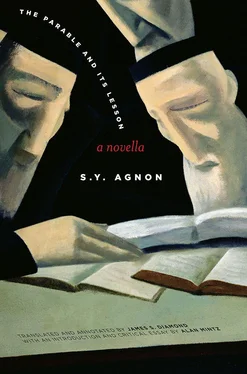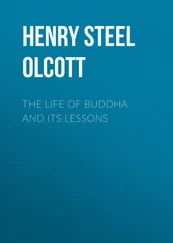41 resembled a silver goblet Agnon is drawing here on the kabbalistic notion that the whiteness or the darkness of one’s hair reflects the nature and quality of the inner self. See Elhanan Shilo, Hakabbalah biyetsirat Shai ‘Agnon [The Kabbalah in the Works of S. Y. Agnon] Ramat Gan: Bar Ilan University Press, 2011, Hebrew), p. 223ff.
42 there had been much persecution See above, note to page 16. Popular legend has it that Meir ben Isaac miraculously saved the Jewish community of Worms, and the Akdamut piyyut commemorates the event.
43 Tosafot note in tractate Gittin The talmudic tractate Gittin treats of the laws of divorce. Zevaḥim treats of the animal sacrifices offered in the Temple. The Rashi comment is found at Zevaḥim 45b. The Tosafot note is at Gittin 54b.
44 of My servant Moses Malachi 3:22.
44 in the Book of the Angel Razi’el Sefer Razi’el hamalakh (Warsaw, n.d.), p. 22. Cited in Shilo, Hakabbalah biyetsirat Shai ‘Agnon , p. 321 note 107.
44 sacrifical offering in the Temple The Tamid offering, described in Numbers 28:1–8.
45 pray the whole day long Babylonian Talmud tractate Berakhot 21a.
46 standing here with me Deuteronomy 5:28.
46 shall a case be established Deuteronomy 19:15.
46 punishment for our transgressions The reference is to Isaiah 40:2.
48 midrash on Songs of Songs Midrash Rabbah on Song of Songs 1:8. Some versions have a different numbering.
48 Midrash Tanhuma A collection of rabbinic midrash in several versions, dating uncertain.
49 It is prayer Babylonian Talmud tractate Ta’anit 2a. The biblical verses respectively are from Exodus 23:25 and Deuteronomy 11:13. The reference to Maimonides is a verbatim citation from his Mishneh Torah , the Laws of Prayer, 1.1.
49 mandated by the Torah itself Naḥmanides (R. Moses ben Naḥman, Ramban, 1194–1270) was a major Bible commentator and halakhist. Maimonides’ Book of the Commandments ( Sefer hamizvot ) is a detailed catalogue of the 248 positive and 365 negative commandments on which Naḥmanides wrote critical glosses, this being among the most famous.
49 from the right earlock of the great teacher In Lurianic Kabbalah, the earlocks are metaphysical signifiers, the right one associated with the holy and the mystical, the left one with the mundane and the philosophical. Thus is Naḥmanides, a kabbalist, privileged over Maimonides. See Shiloh, Hakabbalah biyetsirat Shai ‘Agnon , pp. 226–228.
50 Gates of Light Sha‘arei ’orah , a kabbalistic treatise by Joseph ben Abraham Gikatilla (1248–ca. 1305), Fifth Gate, Sixth Sphere.
50 Midrash ha-ne‘elam The Esoteric Midrash — a kabbalistic text inserted into the main text of the Zohar.
50 Pirke de Rabbi Eliezer A late rabbinic midrash on Genesis, Exodus, and other parts of the Bible. It is ascribed to R. Eliezer ben Hyrcanus (late first, early second century) but is dated to the seventh or eighth century. The reference here is to the explication of Genesis 32:27ff. in chapter 37.
50 his fragrance rubbed off on my hand Talmudic tractate Zevaḥim 96b. The folk saying conveys the idea that one acquires luster through association with an eminent person.
51 knows its own bitterness Proverbs 14:10.
51 the reward of humility is grace An adaptation of Proverbs 22:4.
51 to the children of Israel Leviticus 23:44.
52 and your father’s house Psalm 45:11.
52 never laid eyes on Despite the centrality of Torah study, full sets of the Babylonian Talmud were not then necessarily widely available because of the cost. It is, therefore, not unimaginable for someone not to have seen ‘Eruvin, which is not among the more commonly learned talmudic tractates. The tractate deals with the laws of ‘eruv , the halakhic extension of private property into the public domain so as to permit one to carry objects within it on the Sabbath, which would otherwise be forbidden.
52 could view the minor tractates Tractates of rabbinic teachings on subjects not treated in the Mishnah. They are usually included at the back of some volumes in printed editions of the Babylonian Talmud.
52 weekly Torah portion was Yitro Exodus 18–20. The Decalogue is at 20:1–14.
52 the Ten Commandments in Deuteronomy Deuteronomy 5:6–18, the second iteration of the Decalogue in the Pentateuch.
53 with their children forever Deuteronomy 5:26.
54 how feeble our strength Jeremiah 51:30.
54 study its ways and learn Proverbs 30:25 and 6:6.
54 who dwell in your House Psalm 84:2–5.
54 will die with my nest Job 29:18.
54 all the days of my life Psalm 23:6.
54 would only cite Rabbi Ibn Ezra Rabbi Abraham Ibn Ezra (1089–1164), Spanish grammarian and Bible commentator.
54 the Radak Rabbi David Kimḥi (1160–1235), Provençal grammarian and Bible commentator.
55 who have been banished Psalm 113:3 and 2 Samuel 14:14.
55 passing shadow Psalm 144:4.
56 and trample My courts Isaiah 1:12.
56 who call upon him in truth Psalm 145:18.
57 blame will not be lacking An adaptation of Proverbs 10:19 Where there is much talk, there is no lack of transgression .
57 afflicted, downtrodden, and hurting Talmudic tractate Yevamot 47a.
57 will put an end to words Job 18:1.
57 full-day fast of silence The practice of a “fast of speech,” Ta’anit dibbur , arose only in early modern times as a penance and as a means to achieve greater spiritual elevation. It is not ordained biblically or rabbinically. The time for which it was undertaken varied, and during it the practitioner either kept silent or spoke only about Torah matters.
58 between His shoulders Deuteronomy 33:12.
58 Benjamin is a ravenous wolf Genesis 49:27.
58–59 sit alone and keep silent Lamentations 3:28.
60 to make up the loss Moses Isserles (Rama), citing ’Or Zaru‘a in Shulḥan Arukh, ’Or hahayyim 135:2.
60 moment of truth After 2 Chronicles 32:1.
60 charges with folly Job 4:18.
61 utters in Perek Shira Perek Shira (Passages of Praise) is a poemlike collection of biblical and talmudic verses of praise to God placed in the figurative mouths of the heavenly bodies; the elements of the natural world; the various members of the vegetable, animal, bird, and insect kingdoms; and, as indicated here, Gehinnom. The text appears in authoritative editions of the prayerbook but is not part of the liturgy. Author and date are unknown, but the work may go back to talmudic times.
61 from one end of the world to the other Otzar hamidrashim, Gan ‘Eden/Gehinnom no. 32.
61 rest on that day Otzar hamidrashim, ‘Aseret hadibrot no. 10.
61 judged for twelve months Mishnah ‘Eduyot 2.10.
61 does not descend again Babylonian Talmud tractate Shabbat 153a.
61 fiery glow of Gehinnom Talmudic tractate Ḥagigah 27a.
62 ascribe truth to Jacob Micah 7:20.
63 from the commandment to study Torah Agnon cites this teaching in his Sefer sippur vesofer (p. 105, 108 in new ed.), citing Nathan ben Isaac Jacob Bonn’s Shikḥehat leket (Amsterdam, 1700), who attributes it to the Sodei razaya of Eliezer of Worms (ca. 1176–1238, author of the Rokeah).
64 blessings on behalf of each individual At the conclusion of each section of the Torah reading (aliyah), the gabbai recites a blessing on behalf of the person called to the Torah for that section, as well as for his wife, family, and any other individuals he chooses to name. The blessing includes the sum of money the person stipulates to the gabbai as his pledge to the synagogue for the honor of having been called to the Torah reading.
Читать дальше












![Edward Ellis - Adrift on the Pacific - A Boys [sic] Story of the Sea and its Perils](/books/753342/edward-ellis-adrift-on-the-pacific-a-boys-sic-s-thumb.webp)